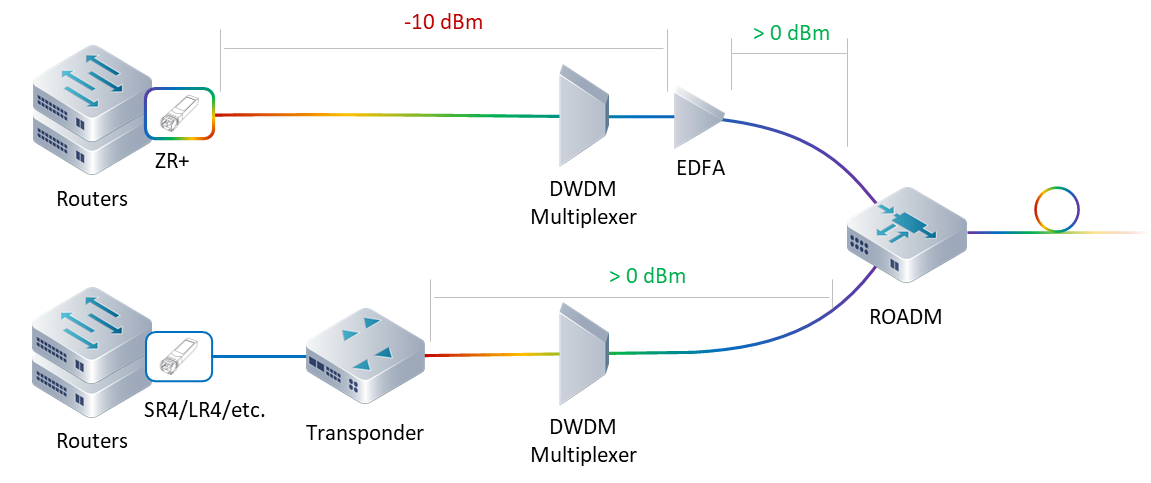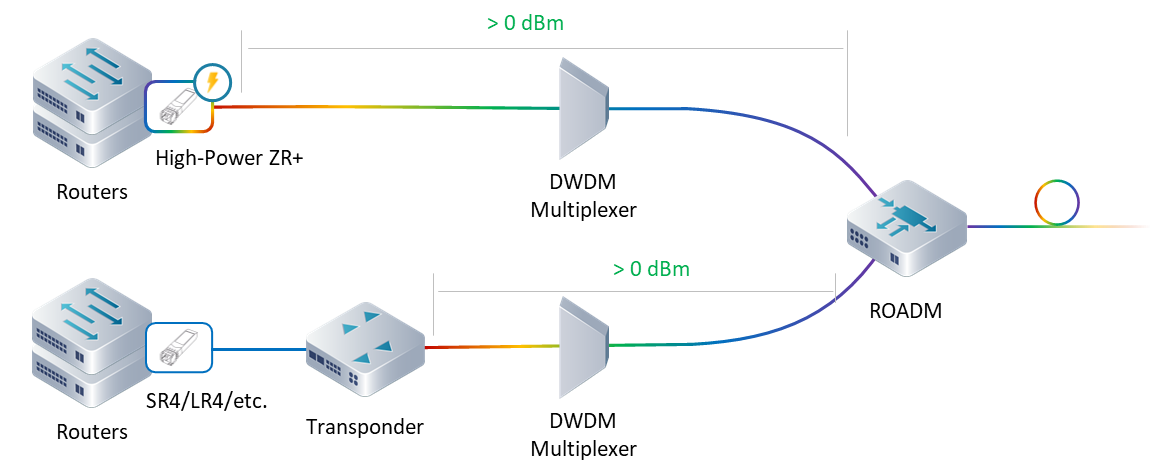Next-Gen Optical Networks with High-Power ZR+ Transceivers
by Victor Khen
There is no wonder how ZR+ continues taking over service providers' networks across the globe as it tackles most of the checkboxes in minds of network architects: high-capacity, high-distance, space saving, energy saving, low cost, redefining network design, yet non-intrusive.
With distance reach of 100s of kilometers and more, these powerful coherent pluggables serve as ideal solutions for most types of networks: metro networks, DCI, remote cell sites, and rural networks.
In our previous blog, we explored the significance of ZR/ZR+ transceivers as an efficient alternative to transponders. Today, we shift our focus to the latest advancement in ZR+ technology - the high-power (high transmit output power) ZR+ transceivers.
In addition, we would like to address the ongoing development of the ZR+ supporting ecosystem. UfiSpace, being an industry leader in open networking, is actively engaged in numerous projects involving ZR+ technology. In the final section of the blog, we will provide a brief overview of the best practices and technological advancements supporting ZR+ coherent pluggables. Stay tuned to learn more about the exciting progress in this field.
It's All About Network Simplification
The first generation of 400Gbps OpenZR+ MSA compliant transceivers have offered a rich set of benefits and become an effective solution for filtered (AWG-based DWDM) point-to-point applications. But they had certain interoperability limitations with reconfigurable optical add- drop multiplexers (ROADM) systems which are widely spread in optical networks.
Table 1. Shows a difference between major optical specifications, such as transmit power and OSNR (optical signal-to-noise ration) of transponders, first generation ZR+ transceivers, and high-power ZR+ transceivers.
Table 1. Optical specifications of typical transponders and ZR+ DCO
One of the key challenges of the first generation of ZR+ is low optical transmit power of -6 to -10dBm. Most of today's optical networks were designed for transponders that operate at +3 to -10dBm. Therefore, early adopters of the ZR+ technology would have to opt for One of the 3 solutions to equalize ZR+ signal transmit power output for interoperability with ROADM:
- Employing external EDFAs or, if available, internal amplifiers, integrated within DWDM Multiplexers or ROADMs, to amplify the low-power ZR+ transceiver signal.
- Leveraging the channel equalization capabilities of the ROADM by attenuating existing channels to bring their power levels closer to -10dBm.
- Allocating a specific ROADM degree exclusively for DCO channels.

Figure 1. First generation ZR+ parallel deployment with transponder
The new generation of high-power ZR+ transceivers can operate at 0dBM or higher of optical transmit power and have lower OSNR ratio, closer to transponders. They no longer require additional amplification and allow seamless deployment in ROADM line systems. They allow to further streamline optical network, reducing network management complexity, power consumption, and cost.

Figure 2. High-power ZR+ parallel deployment with transponder
The Secret Sauce
So, what is in the heart of new high-power ZR+ transceivers? It is the EDFA (erbium doped fiber amplifier), but at much smaller size. The latest advancements in silicon photonics and DSP (digital signal processors) enabled vendor like Cisco, NTT Electronics, Smartoptics, and others to encompass the mini-EDFA along with other optical technologies within the compact QSFP-DD form factor.
How UfiSpace Makes Sure Everything Works
With the introduction of ZR+ technology, switches and routers have become integral components of the optical network. Transceivers now serve as the direct link between switches/routers and the optical network. As a result, the demands placed on switches and routers have significantantly increased.
ZR+ transceivers consume more power and induce higher heat. General 400G QSFP-DD transceivers require 12-15W of power, while ZR+ need 20-25W, therefore per-port power output and heat management become critical considerations.
To date, our team experienced working on projects with ZR+ for remote cell sites, rural broadband, metro networks, edge networks, and data center interconnects (DCI). UfiSpace has placed great emphasis on achieving full interoperability and ensuring reliable operations With the new technology to guarantee the success of each project.

Figure 3. S9610-36D Best Practice: ZR+ Port Mapping for Optimal Heat Dissipation
To ensure the reliable operation of ZR+ pluggables in UfiSpace switches and routers, two important steps were taken. Firstly, the per-port power for QSFP-DD ports was increased to provide ample power for optimal performance. Secondly, best practices with port mappings for more optimal heat dissipation were tested and provided for each of ZR+ compatible platforms. In Figure 3, we present ZR+ port mapping on S9610-36D high density platform, ports highlighted in blue can be used for ZR+ while the rest can be used with general transceivers Simultaneously. This configuration offers maximized resource utilization and optimal heat dissipation.
List of UfiSpace Platforms with Support of ZR+:
Access
- S9510-28DC – 24x 25G SFP28, 2x 100G QSFP28, 2x 400G QSFP-DD 1U Open Router
Aggregation
- S9600-56DX – 48x 100G QSFP28, 8x 400G QSFP-DD 2U Open Router
- S9610-48DX – 40x 100G QSFP28, 8x 400G QSFP-DD 2U Open Router
- S9600-30DX – 16x 100G QSFP28, 8x 100G QSFP-DD, 6x 400G QSFP-DD 2U Open Router
- S9600-28DX – 24x 100G QSFP28, 4x 400G QSFP-DD 2U Open Router
- S9610-36D – 36x 400G QSFP-DD 2U Open Router
Core/Edge
Data Center
- S9300-32D – 32x 400G QSFP-DD 1U L3 Programmable Switches
- S9301-32DB – 24x 200G QSFP56, 8x 400G QSFP-DD 1U L3 Programmable Switch

